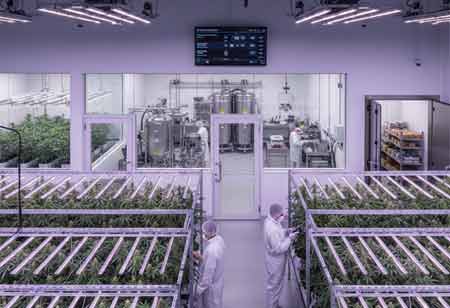Thank you for Subscribing to Cannabis Business Insights Weekly Brief
Crafting Cannabis: Innovations in Extraction Techniques

By
Cannabis Business Insights | Wednesday, March 26, 2025
Stay ahead of the industry with exclusive feature stories on the top companies, expert insights and the latest news delivered straight to your inbox. Subscribe today.
Cannabis extraction plays a pivotal role in the transformation of raw cannabis into high-value products, driving innovation in both the medical and recreational markets. As consumer preferences shift toward more refined and potent cannabis offerings, the industry is witnessing significant advancements in extraction techniques, which not only improve product quality but also improve the efficiency of production processes.
The cannabis extraction industry has seen a remarkable expansion, driven by growing consumer demand for concentrates. This demand is primarily attributed to the increasing use of cannabis for medical purposes and the rise of new consumer preferences for cannabis products that offer enhanced potency, flavor, and precision. The market has evolved from the traditional use of cannabis flowers to a broader spectrum of concentrated products, including waxes, shatter, rosin, and distillates, which offer consumers a more focused form of cannabis consumption.
The Shift Toward Solventless Extraction Methods
A key trend within the market is the rise in popularity of solventless extraction methods, such as rosin pressing. Solventless extractions appeal to consumers who prioritize purity and natural extraction techniques, as they do not involve chemicals like butane or CO2. There is an increasing emphasis on sustainability in extraction methods. Companies focus on environmentally friendly techniques that minimize waste and energy consumption, reflecting consumers' and producers' growing interest in eco-conscious practices.
Another substantial trend is the incorporation of advanced technologies in cannabis extraction. Automation and AI-driven systems are becoming more commonplace in extraction facilities, allowing for greater precision, efficiency, and consistency in the production of concentrates. These technologies ensure that extraction yields are optimized and that the quality of the final product consistently remains high. As the industry matures, these advancements are helping businesses scale up production while maintaining high-quality standards.
Challenges and Opportunities in Regulatory Compliance
Despite the rapid growth of the cannabis extraction industry, several challenges need to be addressed to ensure sustained progress and success. One of the main challenges is navigating the regulatory environment, which differs significantly across regions and can be complex for operators to navigate. Regulations regarding extraction methods, safety standards, labeling, and product quality often vary between jurisdictions, leading to confusion and compliance issues for companies that operate in multiple markets.
A solution to this challenge lies in developing a unified regulatory framework to streamline regional compliance. Industry stakeholders, including cannabis producers, policymakers, and regulators, must collaborate to create standardized regulations that ensure safety while fostering growth in the sector. Companies can also invest in legal expertise and technology solutions to stay compliant with the ever-evolving regulatory landscape, ensuring they can operate smoothly across different markets.
Another challenge the industry faces is the high cost of equipment and infrastructure for cannabis extraction. Specialized equipment, such as CO2 extractors, hydrocarbon systems, and vacuum ovens, can be expensive to acquire and maintain, placing financial pressure on smaller businesses. In addition, the need for skilled labor to operate this equipment adds another layer of cost, further limiting accessibility for smaller players in the industry.
To address these cost challenges, companies can explore opportunities for shared infrastructure, such as co-extraction facilities, where multiple operators share equipment and resources to reduce overhead costs. This approach allows smaller producers to access high-quality extraction equipment without the upfront capital investment. Extraction equipment manufacturers can focus on creating more cost-effective, scalable solutions that cater to both large-scale and smaller-scale operations, enabling broader access to extraction technology.
Ensuring Consistency and Quality in Cannabis Products
Another challenge in cannabis extraction is product consistency and quality control. The extraction process is highly sensitive, and even small temperature, pressure, or time variations can lead to significant differences in the final product. Consumers demand consistency in potency and quality, and any deviation from these expectations can affect brand reputation and sales.
Companies are increasingly investing in automated systems and AI-driven technologies to monitor and control the extraction process to solve this issue. These systems allow for greater precision and the ability to replicate exact conditions for each extraction batch. Implementing robust quality assurance protocols, including third-party testing for potency and purity, helps ensure that products consistently meet the desired standards. By adopting these technologies, companies can improve their ability to produce reliable, high-quality products that meet consumer expectations.
As the cannabis extraction industry continues to grow, numerous opportunities and advancements are emerging that offer significant benefits to stakeholders across the sector. One of the most promising areas of growth is the increasing consumer interest in cannabis edibles and beverages. These products offer an alternative to traditional smoking and vaping, catering to consumers who prefer a more discreet and controlled way of consuming cannabis. Extracts like distillates and THC-rich oils are essential ingredients in the production of edibles, and the demand for high-quality extracts is expected to increase alongside the growth of the edible and beverage market.
Advancements in extraction technology allow the development of new and innovative products that enhance the cannabis experience. For example, advancements in terpene preservation during extraction enable companies to create concentrates that retain the full spectrum of aromas and flavors in the cannabis plant. This has led to terpene-infused oils and concentrates, catering to consumers seeking a more aromatic and flavorful experience. The refinement of solventless extraction methods allows for the production of purer products that appeal to health-conscious consumers.






